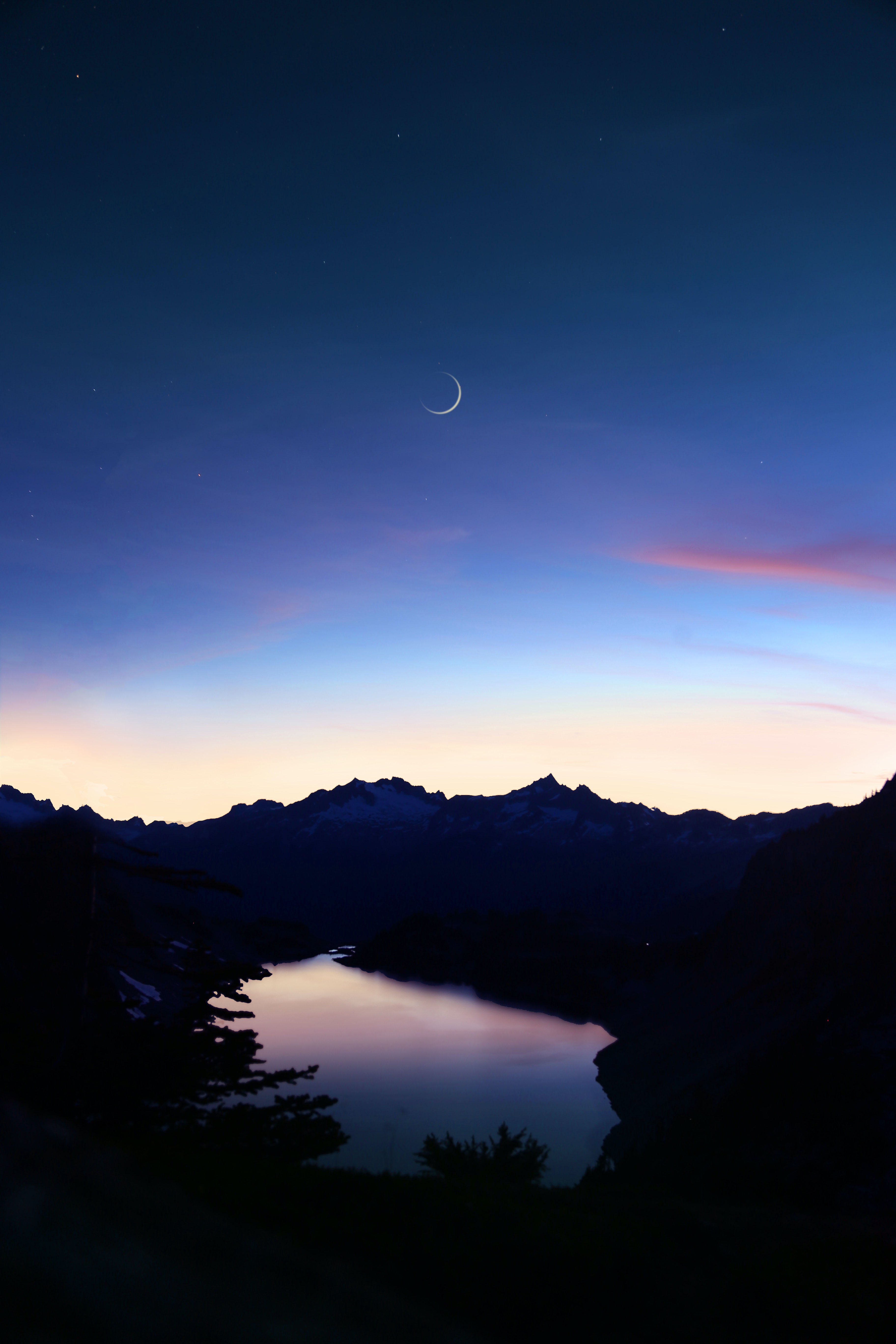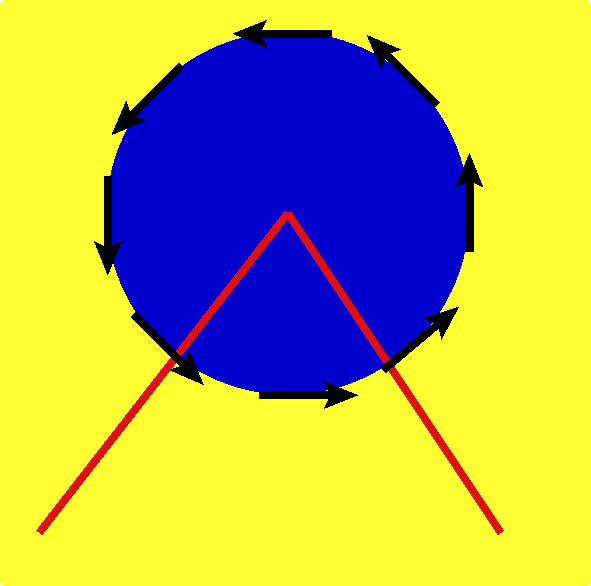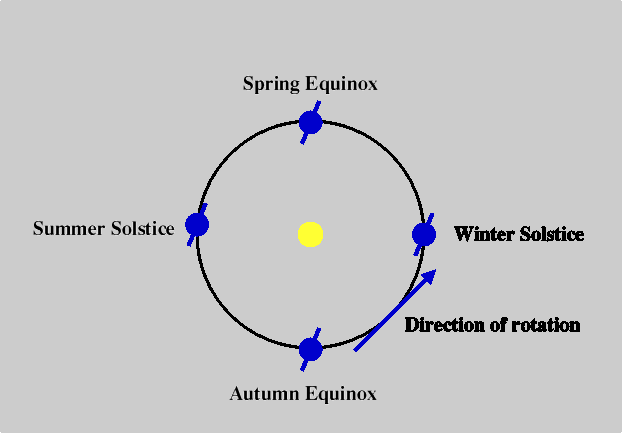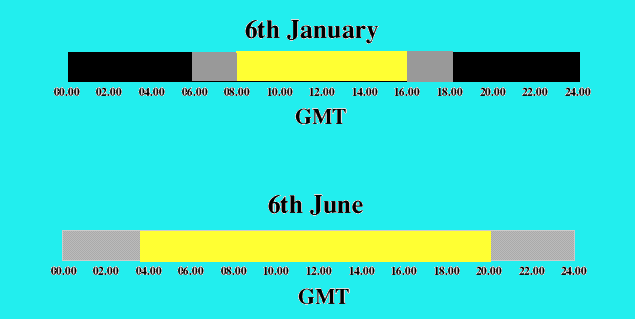Today everyone in the whole world uses the same Calendar, of days, weeks, months and years, although the names used for the days of the week and months of the year may be different in different languages. This Calendar is called the Gregorian Calendar, for reasons described later. This is the Calendar which is built into your computer and tablet and phone.
Today many people, including Jews and Moslems, also use a separate, religious, calendar giving them the dates for their Feasts and Holy Days - an App on your device will convert between the different calendars. But this Page describes only the Gregorian Calendar.
Everyone living today, or who has ever lived, has seen the Sun rise and set - this gives us our days. But our weeks, months and years were also originally based upon what we can see in the sky, even though many people living today do not realise this.
A day is based upon the time it takes for the Earth to rotate on its axis, until the Sun returns to its highest point in the sky, and is twenty four hours long. Today one day ends and the next one starts in the middle of the night, so you go to bed on Monday night and get up on Tuesday morning.
But thousands of years ago most people lived in small communities and worked the land for food, so most human activity stopped at sunset: a sunset is a very definite ending. So one day ended, and so of course the next one started, at sunset.
No one went far from their home after sunset, instead they gathered round the fire and sang and listened to stories; the people who told the stories were called bards. The stories were recited as poetry, which is much nicer and easier to listen to, and also much easier to remember, than what we now call prose. In many places and communities this still happens today.Today when your teacher tells you a story he might use an interactive whiteboard or large screen or projector, but the bards did not have these, so they used the next best thing: the Night Sky! These stories were not written down for hundreds or even thousands of years, they were told many times and passed down from bard to bard with unbelievable accuracy, but no one minded how often they heard them. Even today little children love being told the same bed-time stories again and again - and woe betide the parent who gets a word of it wrong!
Of course after a story has been passed down in this way for more than three thousand years it may have changed a little in the telling, and become what today we call a myth. for example the Greek myths such as Jason and the Argonauts.
Today a week is seven days, but it was originally a quarter of a month - months are described in the next section - so although today the first of the month can be on any day of the week four thousand years ago the first day of the month was always on the first day of the week.
The Babylonians named the seven days of the week after the Sun and Moon and the five planets they could see in the sky, Mercury, Venus, Mars, Jupiter and Saturn. Today in English we still have Sun Day, Moon Day and Saturn Day, but Tuesday, Wednesday, Thursday and Friday are named after the Germanic and Norse Gods and Goddesses Tiw, Woden, Thor and Frigg. But the French still have lundi, mercredi, vendredi, mardi, jeudi and samedi (but not in that order) - note that in French the days of the week, and also the months of the year, do not start with a capital letter. But in France Sunday is Dimanche, from the Latin for the Lord’s Day, which does start with a capital letter.
Originally Sunday was always the first day of the week, but today it is usually taken to be Monday. The Calendar in your PC or tablet or phone uses Monday as the default value, but you can change it if you want to. The weekend is always taken to mean Saturday and Sunday.
Today a month is 28 or 29 or 30 or 31 days long, and there are twelve months in a year, but thirty thousand years ago a month (moon-th, get it?) was based upon the time it took the Moon to go round the Earth.
The Moon goes round the Earth: about once every twenty nine and a half days it crosses a line between the Earth and the Sun. This is more fully explained on the Page on the Moon. The Moon does not give out any light of its own, we see it only because it reflects the light of the Sun, so we can only see the part of the Moon which is facing both the Sun and the Earth. So as the Moon crosses the line between the Sun and the Earth no part of it can be seen from the Earth: this is what astronomers and astronomy Apps on your phone and tablet call the New Moon, what I call the astronomical New Moon, and what everyone else calls absolutely nothing at all - after all they cannot actually see it so why should they be interested in it?
The first time you can actually see the Moon in the sky is as a very tiny crescent in the Western sky just after the first sunset after the astronomical New Moon. This is what I and everyone else who is not an astronomer calls a New Moon. Adult astronomers totally ignore it, but helping Young Star Gazers to look for it is really exciting!

This New Moon must of course be a whole number of days after the last one, so a lunar month must have twenty nine or thirty days.
We know that thirty thousand years our ancestors were looking at the Night Sky because they have left us stunningly accurate pictures of it, painted onto the walls of caves or carved onto the surfaces of rocks. Their pictures of the Milky Way are clearly recognisable. There are also lots of lovely pictures of animals, but often these appear to be all higgledepiggledy: it is only very recently that we have realised they are actually very carefully positioned - they are showing not animals but constellations!
They told the day of the month by using something like a bone with thirty small holes carved into it - archaeologists have found lots of these. The first evening he saw the New Moon the Village Elder would put a peg into the first hole, and then put in another peg every evening until the twenty ninth evening. On the twenty ninth evening he would look for the New Moon. If he saw the New Moon he declared the new month had started and would put the first peg into a new bone, if he did not see it he would put in the thirtieth peg into the old bone and declare that the next evening would start the new month, he did not need to see the New Moon on the thirtieth evening.
Measuring the length of a lunar month is easy, but measuring the length of a year, the time it takes for the Earth to go round the Sun, is much more difficult and requires measurements and calculations which these people simply could not do. They had not yet learned to write so there are no written records but we think they measured time only in months.
Today we might give the age of a baby in days or weeks or months, but if we are asked our own age we will say, for example, sixty six not sixty six years. Many of the myths described in the Days Section are about people who appear to have lived an impossibly long time, so we dismiss them as just made-up stories, until we realise that these numbers are lunar months not calendar years! A calendar year of 365 days is 12.4 lunar months, so although today no one could believe that a man could live to be 600, 600 lunar months is only 48 years.
Later the Babylonians divided a lunar month into four weeks: the first three weeks had seven days and the fourth eight or nine, repeating the name of the seventh day for the eighth and nineth. days.
Today a year is based upon the time it takes for the Earth to go round the Sun, about 365 days, and is twelve calendar months (of 28 or 29 or 30 or 31 days) long and starts on the 1st January, in wintertime. But five thousand years ago it was based on lunar months and started in the spring, which is a much more logical beginning. So the first month of the year was the month containing the spring equinox. But a solar year (based upon the Sun) is about ten days longer than twelve lunar months, or about a month after three years. So near the end of the twelth month of the year the Village Elder would go into the middle of a field and ask himself “Is it really warm enough for next month to be Spring?” and if the answer was NO he just added a thirteenth month! I am told that the best way of deciding this is to sit on the ground with a bare bottom, but I have never tried it for myself. The Jewish religious calendar still works in this way - but probably without the bare bottom!
By a little more than two thousand years ago the Romans had dispensed with lunar months and were using a year of twelve months alternating between 30 and 31 days so as to total 365 days. March, which included the Spring equinox, was the first month of the year, so September, October, November and December were the seventh, eighth nineth, and tenth months, and February was the last. Later Julius Caesar, the first Roman Emperor, renamed a month, July, after himself but originally it only had 30 days in it which was not good enough for him, so he added a day to make it 31 by taking a day out of the last month. (After Julius’s death the next Emperor, Augustus, did the same for August - this is why today February has twenty eight days!) Finally Julius Caesar introduced leap years by adding an extra day to the last month of the year, that is, today's February, every four years - leap years are discussed in the next Paragraph. This Calendar was introduced in 46 BCE and is called the Julian Calendar and was used throughout the whole Roman Empire and Europe for the next one thousand five hundred years, before being replaced by the Gregorian Calendar in 1592 CE - this is explained in the next Section.
If we are on the Big Wheel at a funfair, sometimes we are moving upwards and sometimes downwards, sometimes forwards and sometimes backwards. But we do not actually stop at the point where we change from going up to coming down, it is just a moment in time.

Similarly we may say that June 21st is the longest day, but the summer solstice is not a day of the year it is a moment in time and can be at any time of the day or night, depending on which time zone you are in, it just happens to fall at some time on June 21st for your time zone.

Sam looks up the time of the 2021 Spring Equinox for the Greenwich Observatory on his tablet: it is 09.37 GMT (Greenwich Mean Time) on 20th March. In 2022 it was 15.33 GMT and in 2023 it will be 21.24 GMT. These are about six hours different because the Earth actually goes round the Sun in about 365¼ days not exactly 365 days. So in 2024 the Spring Equinox would be on the 21st of March. So unless we do something about it the date of the Spring Equinox will get a day later about every four years and eventually we will need to take our Summer Holiday in October. What do we do to prevent this? We add an extra day to February (which in Roman times was the last month of the year) every fourth (well almost every fourth) year - Leap Years!
It has been internationally agreed that the March Equinox should always fall at some time on March 20th for the Greenwich Observatory and therefore the Greenwich Time Zone, but this means that it might fall on 19th or 21st March in other time zones. Similarly the Solstices and the September Equinox do not always fall on the same day every year, even for the Greenwich time zone.
The first people to use leap years were the Ancient Egyptians, and you can read about the Ancient Egyptian calendars (note the plural) here. For various reasons they needed to measure the length of the year very accurately indeed and by before 3000 BCE they had measured it as 365¼ days and were putting in a leap year every four years.
It was a Roman living in Egypt who introduced Julius Caesar to the Egyptian Calendar, and he liked it so much that in 46 BCE he made it the official calendar of the Roman Empire. This Calendar was used, initally throughout the Roman Empire and later most of Europe, until 1492 CE and is known as the Julian Calendar.
In fact the time taken for the Earth to go round the Sun is not exactly 365¼ days, and fifteen centuries later the date for the Spring Equinox was out of step with the seasons by nearly fifteen days. In 1492 CE Pope Gregory reformed the Calendar. This Calendar is now known as the Gregorian Calendar. It was initially used only by Roman Catholics but later by most other Christians, and is now the official calendar for the whole world.
In the Gregorian CalendarSo 1700, 1800 and 1900 were not leap years and 2100 will not be, but 1600 and 2000 were.
The Gregorian Calendar will keep the calendar in step with the seasons until at least 4000 CE.
In Britain, and some other places, we put the clocks forward an hour every Spring and back an hour every Autumn. This is called Daylight Saving.
Daylight saving has nothing whatever to do with the Night Sky and almost nothing to do with astronomy, but Sam was curious about it and asked me to explain why we have it.
It was first used about a hundred years ago in Britain, and is still used in Britain, and Sam lives in Britain, so this Section is mainly about its use in Britain, although since it was first used in Britain a few other places have at some time used it, and a few still do. You need not read any further unless you live in a place which still does and, like Sam, are curious about why.
Sam and I use an App on his tablet to look up the times of sunrise and sunset, and some other astronomical data, for January 6th and July 6th for where he lives. Here they are, in graphical form, in Greenwich Mean Time (GMT). The black areas are where the sky is totally dark, the yellow areas are full sunlight and the grey areas show where the sky is getting lighter or darker before and after Sunrise and Sunset - this is more fully explained on the Page on When can we see the stars?

On the days very close to the Summer solstice the night sky where he lives never gets totally dark.
If we look at these drawings we can see that in the winter it will be dark enough to need to have the lights on in the morning, before we go to work or school, and similarly in the evenings when we get home. But in the Summer we shall not usually need the lights on in the morning, and we shall need to have them on for less long in the evening.
Here are the times for June 6th in BST.

We shall still not need the lights on in the morning, before we go to work or school, we may still need to have the lights on in the evening before we go to bed, but for less long than if we had not changed the clocks, that is, we have saved an hour of daylight, hence of course the term daylight saving. Daylight saving can save us energy!
Daylight Saving works best in places where there is about eight hours of sunlight in the winter and sixteen hours in the summer - which happens to be exactly where Sam lives! Nearer the Equator there is much less difference between the length of the days between winter and summer so changing the clocks would have no point, further from the Equator the days are so much longer in the summer that the benefits would be much less.
A hundred years ago Coal was King. Electricity was produced by coal-fired power stations, gas was made from coal, trains were pulled by steam locomotives, machinery in factories was powered by steam engines, both warships and cargo ships were steam-driven.
In 1915 Britain was fighting The Great War with Germany (now called the First World War). Daylight Saving was introduced in Britain in April that year because anything at all that might save coal and so help the British War Effort was considered worth doing.
Some other countries introduced Daylight Saving soon afterwards, but our life-styles and the way we produce and use electricity and other forms of energy have changed so much over the past hundred years that today Daylight Saving makes very little difference to the amount of energy that most people use and so most countries that once used it no longer do so. Surveys in Britain show that most people would not be bothered if it were abolished.
© Barry Gray November 2023